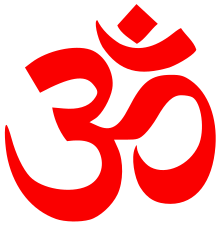Prasthanatrayi
| Part of a series on |
| Hindu scriptures and texts |
|---|
 |
|
Rig vedic
Sama vedic Yajur vedic Atharva vedic |
|
Other scriptures |
| Related Hindu texts |
|
|
Timeline |
Prasthanatrayi (Sanskrit: प्रस्थानत्रयी, IAST: Prasthānatrayī), literally, three sources (or axioms), refers to the three canonical texts of Hindu philosophy, especially of the Vedanta schools. It consists of:[1]
- The Upanishads, known as Upadesha prasthana (injunctive texts), and the Śruti prasthāna (the starting point or axiom of revelation), especially the Principal Upanishads.
- The Brahma Sutras, known as Nyaya prasthana or Yukti prasthana (logical text or axiom of logic)
- The Bhagavad Gita, known as Sadhana prasthana (practical text), and the Smriti prasthāna (the starting point or axiom of remembered tradition)
The Upanishads consist of twelve or thirteen major texts, with a total of 108 texts. The Bhagavad Gītā is part of the Mahabhārata.The Brahma Sūtras (also known as the Vedānta Sūtras), systematize the doctrines taught in the Upanishads and the Gītā.
All the founders of the three major schools of Vedanta, viz, Adi Shankara, Ramanujacharya, and Madhva wrote bhāṣyas (commentaries) on these texts.
Notes
- ↑ Vepa, Kosla. The Dhaarmik Traditions. Indic Studies Foundation.
References
- Madhva; Bannañje Govindācārya (1969). Sarvamūlagranthaḥ: Prasthānatrayī. Akhila Bhārata Mādhva Mahā Maṇḍala Prakāśanam. Retrieved 8 June 2013.
- Paramananda Bharathi (Swami.) (2010). Vedānta prabodha: Prasthānatrayī Śaṅkarabhāshya kā tāttvikasāra. Caukhambā Surabhāratī Prakāśana. ISBN 978-93-80326-40-5. Retrieved 8 June 2013.
See also
This article is issued from
Wikipedia.
The text is licensed under Creative Commons - Attribution - Sharealike.
Additional terms may apply for the media files.